Islam in Mexico
Islam is a minority religion in Mexico. According to the 2010 census conducted by the National Institute of Statistics and Geography (INEGI), there were 2,500 individuals that identified Islam as their religion.[1] The majority are Sunnis and a minority are Shiites or Ahmadiyyas.[2][3]
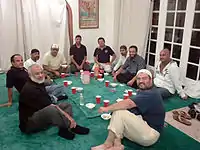
| Islam by country |
|---|
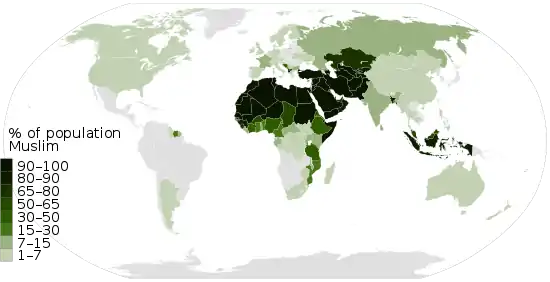 |
|
|
Organizations
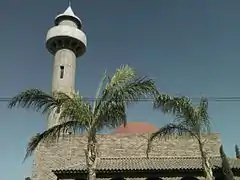
Today, most Mexican Islamic organizations focus on grassroots missionary activities which are most effective at the community level.
The Centro Cultural Islámico de México (CCIM), a Sunni organization headed by Omar Weston, a British born Mexican convert to Islam, has been active in several big cities in northern and central Mexico. In the state of Morelos, the CCIM built a prayer hall and centre for recreation, learning and conferences, called Dar as Salaam, which also operates Hotel Oasis, a hotel that offers halal holidays for Muslim travellers and accommodation for non-Muslims sympathetic to Islam. This group was the subject of a study carried out by British anthropologist Mark Lindley-Highfield of the Department of Anthropology at the University of Aberdeen. Apart from CCIM there is a branch of the Nur Ashki Jerrahi Sufi Order in Mexico City which is often at odds with the traditionalist Muslim community and is headed by two women, Shaykha Fatima Fariha and Shaykha Amina Teslima. There is also a small Salafi organization (the Centro Salafi de México) led by Muhammad Abdullah Ruiz (a former deputy to Weston) and an educational centre managed mainly by Muslims from Egypt and the Middle East, el "Centro Educativo de la Comunidad Musulmana en México" (run by Said Louahabi),and centro al hikmah run by Isa Rojas a Mexican convert to Islam, who studied Islamic studies in the University of Medina, within the capital city.
Demographics
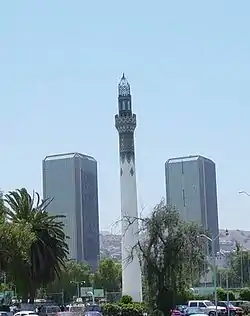
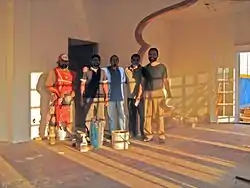
Islam represents less than 0.01% of the population.[4]
| Federal Entity | Muslim Population (2010) |
|---|---|
| 2,000 | |
| 32 | |
| 190 | |
| 20 | |
| 32 | |
| 70 | |
| 16 | |
| 310 | |
| 78 | |
| 34 | |
| 100 | |
| 26 | |
| 38 | |
| 202 | |
| 117 | |
| 200 | |
| 98 | |
| 15 | |
| 126 | |
| 758 | |
| 106 | |
| 100 | |
| 142 | |
| 56 | |
| 200 | |
| 45 | |
| 13 | |
| 63 | |
| 19 | |
| 86 | |
| 43 | |
| 13 | |
| 500 |
Indigenous Mexican Muslims

The Spanish Murabitun community, the Comunidad Islámica en España, based in Granada in Spain, and one of its missionaries, Muhammad Nafia (formerly Aureliano Pérez), now emir of the Comunidad Islámica en México, arrived in the state of Chiapas shortly after the Zapatista uprising and established a commune in the city of San Cristóbal. The group, characterized as anti-capitalistic, entered an ideological pact with the socialist Zapatistas group.[5] President Vicente Fox voiced concerns about the influence of the fundamentalism and possible connections to the Zapatistas and the Basque separatist organization Euskadi Ta Askatasuna (ETA), but it appeared that converts had no interest in political extremism.[5] By 2015, many indigenous Mayans and more than 700[6] Tzotzils have converted to Islam.[7] In San Cristóbal, the Murabitun established a pizzeria, a carpentry workshop[8] and a Quranic school (madrasa) where children learned Arabic and prayed five times a day in the backroom of a residential building, and women in head scarves have become a common sight.[5] Nowadays, most of the Mayan Muslims have left the Murabitun and established ties with the CCIM, now following the orthodox Sunni school of Islam. They built the Al-Kausar Mosque in San Cristobal de las Casas. Nevertheless, the vast majority of Native Mexicans today are non-Muslims.
Mosques
This is a list of some but by no means all mosques and Islamic meeting centers in Mexico.
- Centro Islámico del Norte Calle Mariano Matamoros 1277, Maria Luisa, Centro, 64000 Monterrey, N.L., Mexico
- Suraya Mosque in Torreon, Coahuila.
- Dar es Salaam Mosque in Tequesquitengo, Morelos.
- Tahaarah Mosque in Comitan, Chiapas.
- Al Kautsar Mosque in San Cristobal de las Casas, Chiapas.
- Al Medina Mosque in San Cristobal de las casas, Chiapas
- Musala Tlaxcala #30 San Critobal de las Casas, Chiapas
- Murabitun Mosque San Cristobal de las casa, Chiapas
- Salafi Mosque Muhammad ibn Abdul Wahab in Mexico City.
- Mezquita/ tekke de la Orden Jalveti Yerraji instituto Luz Sobre Luz in Mexico City.
- Masiid Omar, Centro Islamico Tijuana Beaches, Baja California, Mexico.
- Al-Hikmah Ciudad de México, Aragón, Mexico.
- Mezquita Euclides Euclides 25, Col. Anzures, Polanco, Ciudad de México.
- Mezquita de guadalajara Centauro 2912, La Calma, 45070 Zapopan, Jal. Guadalajara.
- Musalah Al Ajirah in Margarita # 5 local, colonia Santa Maria la Ribera, Delegación Cuauhtémoc, CP 06400, Mexico City.[9]
Notable Mexican Muslims
- Fitra Ismu Kusumo, Indonesian artist living in Mexico.
Moorish architecture in Mexico
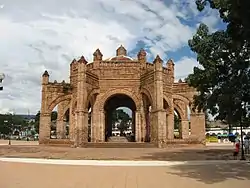

In Chiapa de Corzo, Chiapas, a fountain, known locally as "La Corona" or "La Pila" was built to provide the population with water. This architectural work was built in annealed brick with a strong Mudejar influence.[10] It was built by the Spanish Dominican friars during the Colonial era in the sixteenth century.[11]
The Morisco Kiosk (Moorish Kiosk) in Colonia Santa María la Ribera was made by José Ramón Ibarrola for the Universal Exhibition of New Orleans from 1884-1885, in the neo-Mudejar style that was prevailing in Spain in the 19th century.[12][13]
See also
References
- Instituto Nacional de Estadística y Geografía (2010). "Censo de Población y Vivienda 2010 — Cuestionario básico". INEGI. Retrieved 4 March 2011.
- Tottoli, Roberto (19 September 2014). Routledge Handbook of Islam in the West. p. 157. ISBN 9781317744023. Retrieved 2 November 2014.
- Kusumo, Fitra Ismu (2004). El Islam en el México Contemporáneo (Thesis) (in Spanish). Escuela Nacional Antropología e Historia. ASIN B00EJL9KFW.
- "Mexican Catholics find God in Islam". Public Radio International. 13 February 2014. Retrieved 19 March 2017.
- Glüsing, Jens (28 May 2005). "Islam Is Gaining a Foothold in Chiapas". Der Spiegel. Retrieved 13 November 2011.
- "Indígenas musulmanes abren plática sobre el Islam en San Cristóbal". quadratin.com. 22 August 2015. Retrieved 19 March 2017.
- Lara Klahr, Marco. 2002. “¿El Islam en Chiapas?: el. EZLN y el Movimiento Mundial Murabitun,”. Revista Académica para el Estudio de las. Religiones 4(2002): 79-91 (in Spanish)
- "Islam is the new religion in rebellious Mexican state Chiapas". RNW media. Retrieved 27 November 2015.
- "Musalah Al Ajirah - Cuauhtémoc - HERE WeGo". HERE WeGo. Retrieved 31 October 2017.
- "Chiapa de Corzo" (in Spanish). Chiapas, Mexico: Secretaría de Turismo de Chiapas. Archived from the original on January 19, 2011. Retrieved May 11, 2020.
- "Chiapa de Corzo". Enciclopedia de los Municipios de México Estado de Chiapas (in Spanish). Mexico: Instituto Nacional para el Federalismo y el Desarrollo Municipal and Gobierno del Estado de Chiapas. 2005. Archived from the original on March 27, 2012. Retrieved May 11, 2020.
- Arturo Reyes Fragoso (August 13, 2006). "Santa María la Ribera, colonia centenaria" [Santa María la Ribera, the century colonia]. El Universal (in Spanish). Mexico City. Retrieved May 11, 2020.
- "El Kiosco Morisco de Santa María la Ribera, ícono de la CDMX". mexicodesconocido.com.mx. Retrieved 11 May 2020.
External links
- Centro Cultural Islamico de México, A.C. (Spanish)
- Centro Educativo de la Comunidad Musulmana A.C (Spanish)